In recent years the little Tanzanian micro-habitat specialist, Lygodactylus williamsi, was nearly wiped out. They are currently listed on the IUCN Red list as Critically Endangered and protected by CITES - Appendix I and Annex B of EU Wildlife Trade Regulation.
The purpose of this document is to provide a general overview and history of the species and how it became critically threatened.
This Species Can Be Found:
On the African continent, on the East coast of the United Republic of Tanzania
Common Pet Trade Name(s):
Electric Blue Day Gecko, Williams gecko, Turquoise Dwarf Gecko, blue gecko, electric blue gecko, and blue day gecko.
Scientific Name:
Lygodactylus williamsi
Taxonomy / Classification:
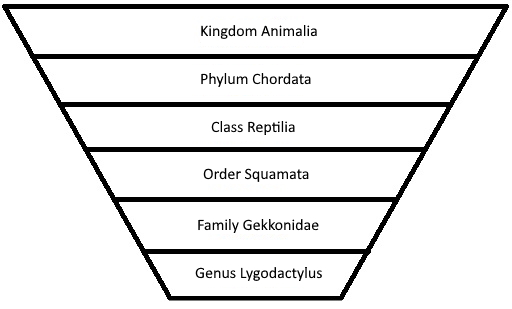
(Flecks, et al., Lygodactylus williamsi. The IUCN Red List of
Threatened Species 2012: e.T14665363A14665385, 2012)
Species description / Characteristics:
In 1952 Arthur Loveridge, a British born biologist and herpetologist, wrote about animals he saw and gathered during his travels to East Africa, particularly in Tanzania. In his journal, he wrote about a little-known, vibrantly-colored gecko. He described it as, "A startlingly turquoise-blue gecko from Tanganyika,” and he named it williamsi (Loveridge, 1952). Lygodactylus williamsi is only 8.5 centimeters from the snout to the tip of the tail, with the females of the species being slightly smaller. L. williamsi displays sexual di-chromatism, which is a form of sexual dimorphism where the males and females of this species differ in color.
Both males and females have a black line that runs on each side of the head from the snout through the eye just past the neck. There is a second line which is V-shaped; this runs parallel to the line and appears on top of the head.

Image 1: The dark lines, a trait specific to the species, runs through the eye and creates a V on top of the head.
The base color of adult males is a bright electric blue, which extends over the entire top portion of the body. The females are colored either golden or various shades of green to blue-green. On the underside both sexes vary in color from pale yellow to bright orange. The throats of the males vary from shades of blue with black markings to solid black. The throats of the females are lighter blue to green devoid of markings. In some cases females can also exhibit a darker coloration of the throat (Baldamus & Hluschi, 2013).

Image 2: Range of variation in throat color and markings in Lygodactylus williamsi. Photo by: M. Flecks & F. Weinsheimer.

Image 3: Color differences between the Lygodactylus williamsi male and female. Photo by: M. Flecks & F. Weinsheimer.
The Caudal Autotomy (Reproductive area):
Between the hind legs, both males and females have pre-anal pores, but these are much more pronounced in the males. As with most young reptiles, it is very difficult to determine gender when the animals are still juveniles; but as they age, it becomes much easier to identify the pre-anal pores on the males (see Image 4).
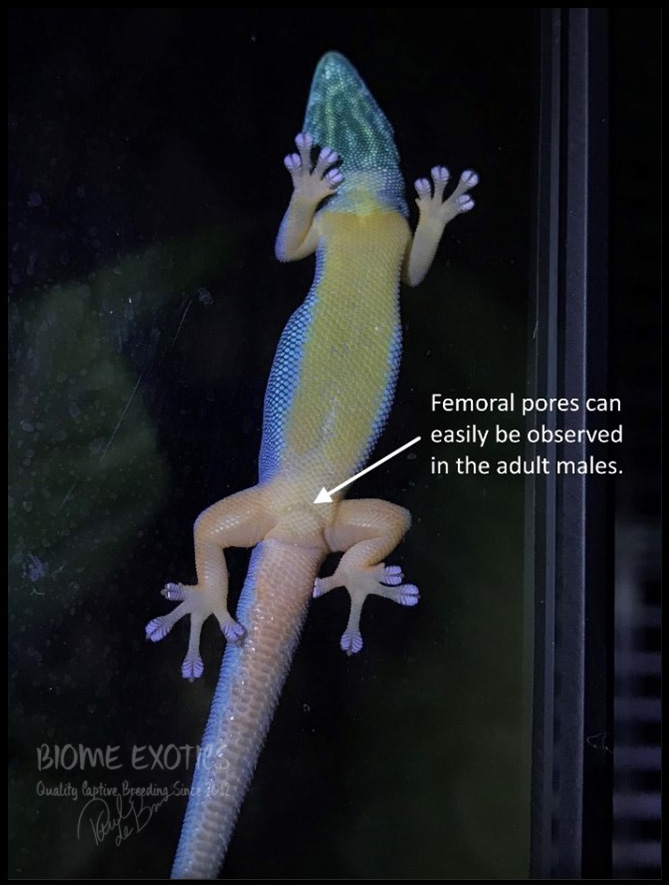
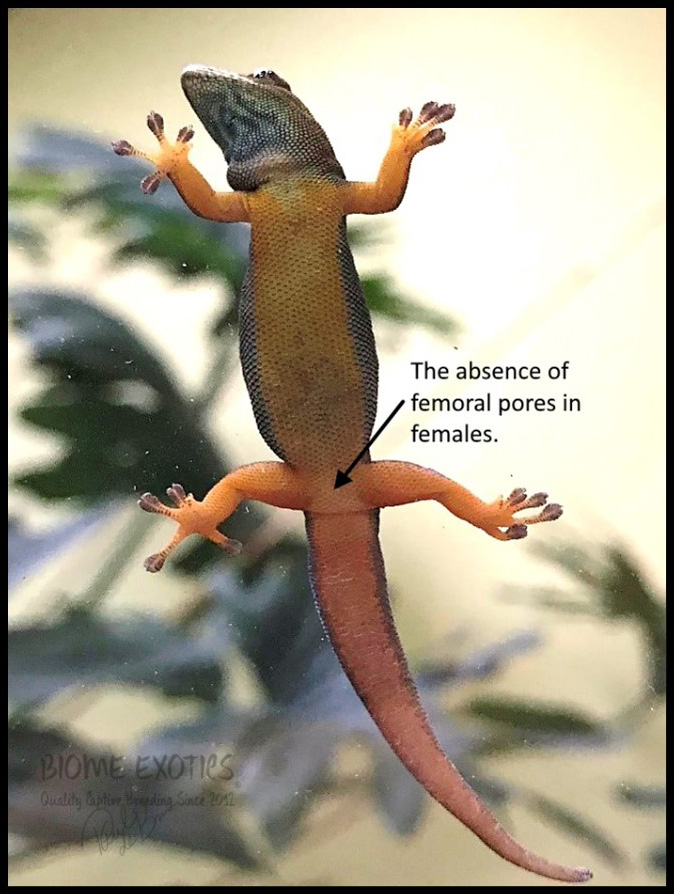
Image 4: Male and female Lygodactylus williamsi identification. Femoral pores, which are more clearly visible on the males, appear as a series of pits or holes within a row of scales on the ventral portion of the animal's thigh.
Appendage Type:
As with all the other species in the genus, Lygodactylus williamsi they can stick to visibly smooth surfaces because their bulbous toes are covered with hundreds of tiny microscopic hairs called setae. Each seta splits off into hundreds of even smaller bristles called spatulae, allowing them to virtually defy gravity. Lygodactylus williamsi is considered an arboreal gecko species spending all of its life in a palm type plant called a Pandanus rabaiensis.
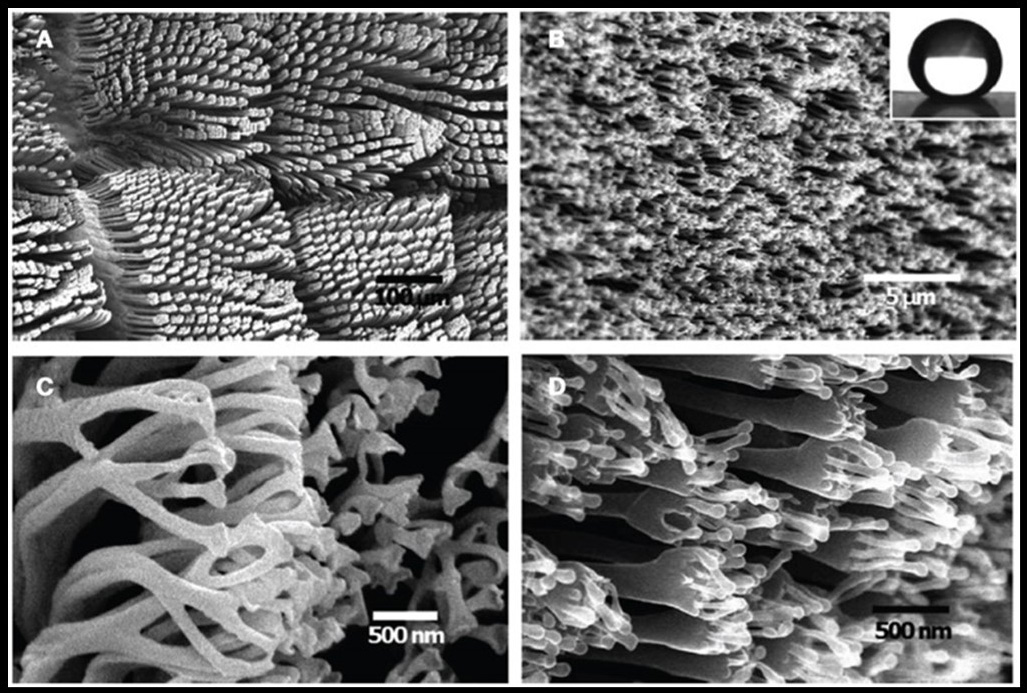
Image 5: A, B, C, and D are magnified images in progressive order of magnification, of a Lygodactylus williamsi toe pad. The microscopic setae are, arranged by the hierarchical fibrillar structure: Gecko toe pad, Gecko setae, a single seta, and the spatulae. Photo by: Lee et al. (2012).
Vulnerability Status:
Currently Lygodactylus williamsi has been declared to be Critically Endangered. Lygodactylus williamsi was placed under the EU Appendix B protection in December 2014, and under EU Appendix A protection in January 2017, and under the CITES Appendix I protection in January 2017. We provided links to each respective site below for additional information.
- [Official Journal L 320 of the European Union Volume 62 11 December 2019]
- [CITES (the Convention on International Trade in Endangered Species of Wild Fauna and Flora)]
Ongoing Conservation Efforts:
The Kimboza forest protection and management project was set up in 1964 and remains controlled by the Tanzania Forest Services Agency. It is currently recognized as an International Union for Conservation of Nature (IUCN) Category IV - Habitat/Species Management Area. The range where Lygodactylus williamsi lives falls inside the protected boundaries of the park and is regularly patrolled by forest rangers. Read more about the management project [here] (https://www.rufford.org/projects/charles_kilawe)
The European Association of Zoos and Aquaria initiated the first Lygodactylus williamsi captive breeding project and studbook in 2013. Read more about the organization [here] (https://www.eaza.net)
Lygodactylus williamsi was placed under the Convention on International Trade in Endangered Species of Wild Fauna and Flora (CITES) Appendix I protection in January 2017 (CITES, 2017). CITES protects threatened and endangered animals through a system of classifications and licensing. Threatened species are categorized into one of three Appendices: I, II, and III. Categorization often follow the species’ threat status on the Red List of the International Union for Conservation of Nature, which was first established in 1964. CITES Appendix I prohibits trade in species which are classified as highly endangered. Read more about CITES [here] (https://cites.org/eng)
Conservation through Commercialization has been practiced for quite some time. This is an incredibly successful approach to reducing the overall demand for specimens collected in the wild and sold illegally in the global pet trade.
Activity Period:
Lygodactylus williamsi is considered diurnal; thus, it is active during the daytime. This makes the species especially attractive to would be pet owners since they are visible and active during the day.
Notable Behavioral Traits:
This particular species can be very bold, territorial, active, and social. In the wild these animals generally live their entire lives on a single Pandanus plant, which is why the males are very territorial and won’t tolerate the presence of other males. Social gestures, may include lateral flattening, puffing out of the throat patch, arching the back, head shaking, head bobbing, and tail-wagging. Many of these behavioral traits may also be observed in captivity. Colors of individuals can also vary depending on their mood, stress level or temperature. Male colors can range from black, to gray, to brilliant electric blue. The females range from dark brown to brilliant green with turquoise highlights.
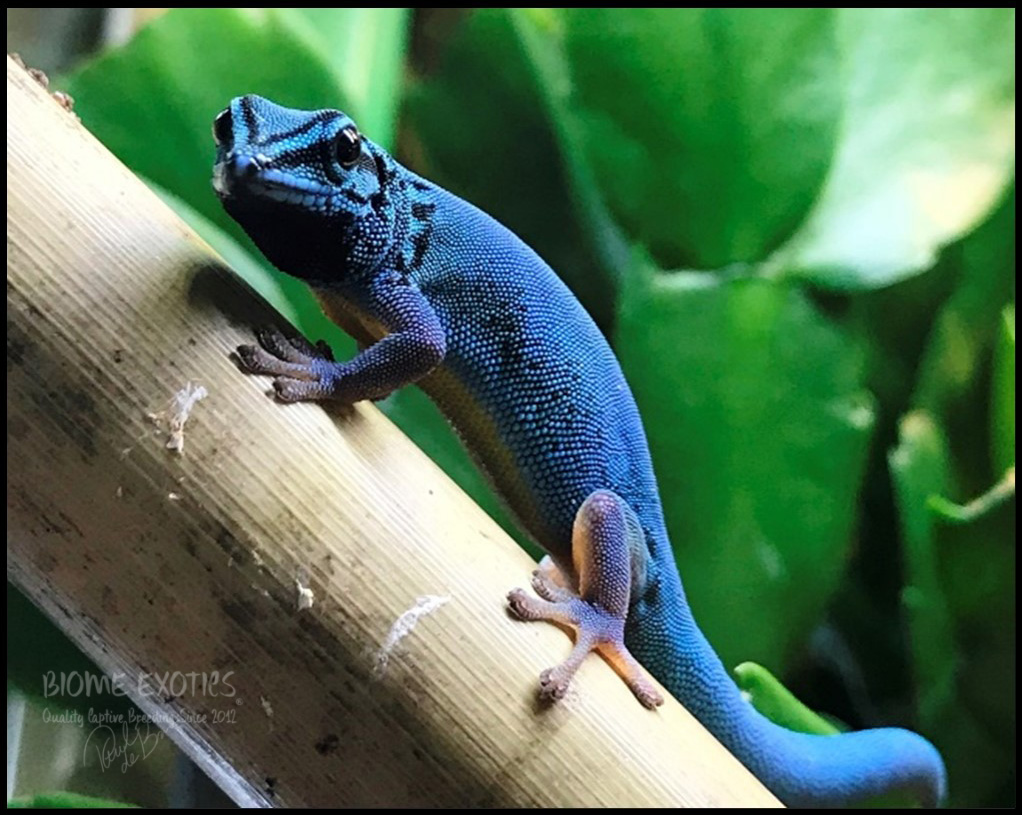
Image 6: A captive bred male Lygodactylus williamsi making territorial gestures to a rival male by puffing his throat sack, arching his back and bobbing his head up and down.
Geographic Range:
These brilliantly colored denizens of a microhabitat can only be found on the African continent in the United Republic of Tanzania. The species is confined to a minuscule 20 square kilometer area within the Kimboza and Ruvu Forest Reserves in the Morogoro Region.
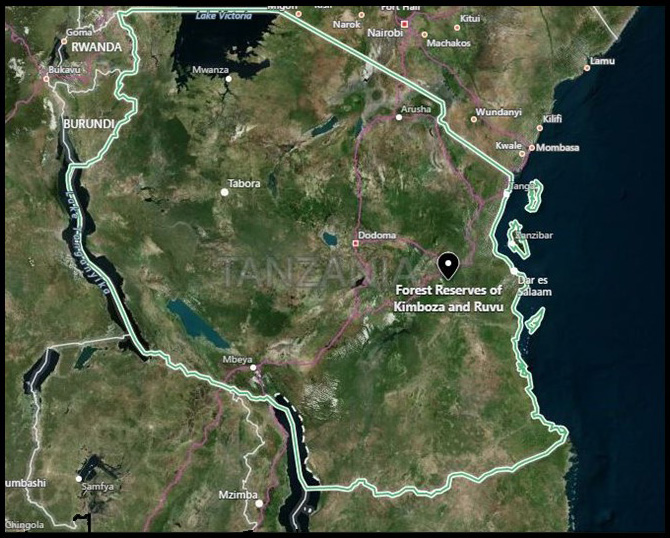
Image 7: Map of Tanzania, depicting the only known location for Lygodactylus williamsi.

Image 8: Distribution of Lygodactylus williamsi. Dashed lines indicate
the reserve borders of the Kimboza Forest Reserve (A) and Ruvu Forest Reserve (B); dots mark individual localities (i.e., inhabited plants) of measured specimens, including the newly discovered populations at Muhalama (C) and Mbagalala (D).
Habitat and Vegetation:
Wild Lygodactylus williamsi reside and propagate exclusively on a single type of native palm-like, dioecious tree called a screwpine, more commonly known by its scientific name the Pandanus rabaiensis rendle. The genus Pandanus falls in the major group entitled Angiosperms (The Plant List, 2013) (see image 9 below). The Pandanus rabaiensis is not evenly dispersed around the Kimboza Forest, but occurs in isolated patches where it is commonly the dominant vegetation element (Flecks, et al., Watching extinction happen: the dramatic population decline of the critically endangered Tanzanian Turquoise Dwarf Gecko, Lygodactylus williamsi, 2012, pp. 12-20).

Image 9: Pandanus rabaiensis native to Kimboza Forest Reserve.
Lygodactylus williamsi inhabits the tropical forest along the eastern foothills of the Ulu-guru Mountains, at altitudes between 170 and 480 meters (560 - 1,570 feet), where they exclusively reside on the Pandanus rabaiensis plant. This plant only grows in swampy areas or in areas with a limestone substratum. Typically, only one male and one or more females, with several juveniles, inhabit a single Pandanus rabaiensis plant.

Image 10: Uluguru Mountains just beyond the Kimboza Forest Reserve in Morogoro, Tanzania.

Image 11: The habitat of Lygodactylus williamsi in Kimboza Forest, eastern slopes of the Uluguru Mountains.

Image 12: The habitat of Lygodactylus williamsi in Kimboza Forest, eastern slopes of the Uluguru Mountains.
Local Climate:
The current mean annual temperature around the eastern slope of the Uluguru Mountain Forest in December is about 24.3° C with a maximum of 26.5° C and a minimum of 21.1° C in July (Lyamuya et al., 1994). This is up slightly according to Jens et al, who noted 1993 temperatures ranging from 19.5° C to a maximum of 22° C in December and a minimum of 17° C in July. The change in mean temperatures may be due to the effect of human alteration of the local habitat - specifically deforestation, which subsequently led to a decline of rainfall and cloud cover.
CURRENT WEATHER FORECAST IN MOROGORO TANZANIA NEAR THE KIMBOZA FOREST
Populations and Reasons for their Decline:
Unfortunately, wild L. williamsi populations have been severely depleted due to habitat destruction, clearcutting for agriculture, the increased frequency of wildfires, population fragmentation, and illegal collection for the international pet trade. It is estimated that about 15% of the species in the was illegally collected for thr pet trade between 2004 and 2009, and according to the International Union for Conservation of Nature and Natural Resources, the identifiable fraction or subdivision of the living population in the Kimboza Forest Reserves was estimated to be roughly 150,000 individuals in 2009 (Flecks, et al., Lygodactylus williamsi. The IUCN Red List of Threatened Species 2012: e.T14665363A14665385, 2012).
Another major impact leading to the decline of L. williamsi has been the introduction of an invasive tree species (Cedrela odorata) planted by locals as a source of lumber. Cedrela odorata was introduced to the Kimboza Forest Reserve in two phases. In 1957 there was a trial phase, which involved planting the tree species in one two hectare plot. This was followed by an establishment phase in 1960, whereby six hectares of Cedrela was planted with the aim of harvesting the fast growing tree for timber and firewood. A very thorough field research study was conducted by Dr. Charles J. Kilawe on the encroaching Cedrela odorata species on the 31st Aug 2016.
Even though the majority of the range where L. williamsi resides was reported to be within a protected area managed by the Tanzania Forest Services Agency, ongoing degradation of the remaining habitat from illegal logging, firewood collection, bushfires, and mining are still being reported, especially as a result of a lack of funding to employ additional rangers and equipment (Flecks, et al., Watching extinction happen: the dramatic population decline of the critically endangered Tanzanian Turquoise Dwarf Gecko, Lygodactylus williamsi, 2012).
References:
Baldamus, P., & Hluschi, D. (2013, Dec 21). The Genus Lygodactylus. Retrieved 2018, from dwarfgeckos.com: http://dwarfgeckos.com/lygodactylus/l_w/lygodactylus_williamsi.php
CITES. (2017). Consideration of Proposals for Amendment of Appendices I and II. CITES. Convention on International Trade in Endangered Species of Wild Fauna And Flora. Retrieved 2018, from https://cites.org/sites/default/files/eng/cop/17/prop/060216/E-CoP17-Prop-30.pdf
Flecks, M., Weinsheimer, F., Böhme, W., Chenga, J., Lötters, S., & Rödders, D. (2012). Lygodactylus williamsi. The IUCN Red List of Threatened Species 2012: e.T14665363A14665385. Retrieved 2018, from International Union for Conservation of Nature: http://dx.doi.org/10.2305/IUCN.UK.2012-1.RLTS.T14665363A14665385.en
Flecks, M., Weinsheimer, F., Böhme, W., Chenga, J., Lötters, S., & Rödders, D. (2012, April 30). Watching extinction happen: the dramatic population decline of the critically endangered Tanzanian Turquoise Dwarf Gecko, Lygodactylus williamsi. Salamandra, 48(1), 12-20.
Loveridge, A. (1952). A startlingly turquoise-blue gecko from Tanganyika. Journal of the East African Natural History Society, 20:(1), 446. Retrieved 2018
The Plant List. (2013). Pandanus rabaiensis Rendle., 1.1. Retrieved 2018, from The Plant List a Working list of all Plant Species: http://www.theplantlist.org/tpl1.1/record/kew-284851
Image References:
Image 5: SEM images of a Gecko (A,C) and fabricated hierarchical polystyrene (PS) nanohairs with high aspect ratio (AR) (B,D). Inset in (B) water contact angle of the elongated hierarchical PS nanohairs. From Lee et al. (2012).
Image 7: Bing. n.d. Map of Tanzania. Microsoft. See: https://www.bing.com/search?q=map+of+tanzania+africa&qs=AS&pq=map+of+tan&sk=AS1&sc=8-10&cvid=67A8F216CA6E40BC931DEDCBFD77A225&FORM=CHRDEF&sp=2.
Image 8: Distribution of Lygodactylus williamsi. Dashed lines indicate the reserve borders of the Kimboza Forest Reserve (A) and Ruvu Forest Reserve (B); dots mark individual localities (i.e., inhabited plants) of measured specimens, including the newly discovered populations at Muhalama (C) and Mbagalala (D). Satellite image from Google Earth/GeoEye.
Image 9: Kilawe CJ. 2017 Aug 21. Invasive plant species Cedrela odorata replacing the habitat of Critically Endangered Lygodactlyus williamsi at Kimboza Forest Reserve. Sokoine University of Agriculture. See: https://www.sua.ac.tz/news/invasive-plant-species-cedrela-odorata-replacing-habitat-critically-endangered-lygodactlyus.
Image 10: Uluguru Mountains just beyond the Kimboza Forest Reserve in Morogoro, Tanzania. Van Heygen, Emmanuel. “a Photo on Flickriver.” Flickriver, 2008, www.flickriver.com/photos/evanheygen/3083201004/.
Image 11: The habitat of Lygodactylus williamsi in Kimboza Forest, eastern slopes of the Uluguru Mountains. Van Heygen, Emmanuel. “a Photo on Flickriver.” Flickriver, 2008, www.flickriver.com/photos/evanheygen/3083201596/.
Image 12: The habitat of Lygodactylus williamsi in Kimboza Forest, eastern slopes of the Uluguru Mountains. Van Heygen, Emmanuel. “a Photo on Flickriver.” Flickriver, 2008, www.flickriver.com/photos/evanheygen/ 3082364395/.
Table of Images:
Image 1: The dark lines, a trait specific to the species,
runs through the eye and creates a V on top of the head.
Image 2: Range of variation in throat color and markings
in Lygodactylus williamsi. Photo by: M. Flecks & F. Weinsheimer.
Image 3: Color differences between the Lygodactylus
williamsi male and female. Photo by: M. Flecks & F. Weinsheimer.
Image 4: Male and female Lygodactylus williamsi identification. Femoral pores,
which are more clearly visible on the males, appear as a series of pits or holes
within a row of scales on the ventral portion of the animal's thigh.
Image 5: The microscopic setae of an Electric Blue day gecko,
arranged by the hierarchical fibrillar structure and magnification:
Gecko toe pad, Gecko setae, a single seta, and the spatulae.
Image 6: A captive bred male Lygodactylus williamsi making
territorial gestures to a rival male by puffing his throat sack,
arching his back and bobbing his head up and down.
Image 7: Map of Tanzania, depicting the only known
location for Lygodactylus williamsi.
Image 8: Distribution of Lygodactylus williamsi. Dashed lines indicate
the reserve borders of the Kimboza Forest Reserve (A) and Ruvu Forest Reserve (B);
dots mark individual localities (i.e., inhabited plants) of measured specimens,
including the newly discovered populations at Muhalama (C) and Mbagalala (D).
Black dots indicate known colonies of Lygodactylus williamsi.
Image 9: Pandanus rabaiensis native to Kimboza Forest Reserve.
Image 10: Uluguru Mountains just beyond the Kimboza Forest Reserve in Morogoro, Tanzania.
Image 11: The habitat of Lygodactylus williamsi in Kimboza Forest, eastern slopes of the Uluguru Mountains.
Image 12: The habitat of Lygodactylus williamsi in Kimboza Forest, eastern slopes of the Uluguru Mountains.


